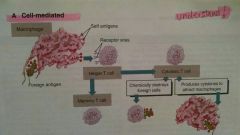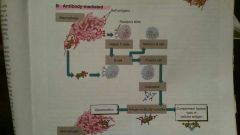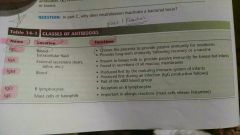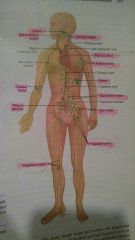![]()
![]()
![]()
Use LEFT and RIGHT arrow keys to navigate between flashcards;
Use UP and DOWN arrow keys to flip the card;
H to show hint;
A reads text to speech;
32 Cards in this Set
- Front
- Back
|
Functions of the lymphatic system
|
- return tissue fluid to blood (assistance in normal blood pressure)
-protects body against foreign antigens |
|
|
Anatomy of Lymphatic system
|
-lymph
-lymph vessels -lymph nodes/nodules -spleen -thymus |
|
|
Lymph
|
-found in lymphatic vessels (water/fluid)
-similar to plasma, but has an increased amount of white blood cells |
|
|
Lymphatic vessels
|
-begin as dead- end lymph capillaries
-found in tissue spaces -permeable: collect tissue fluid and proteins -lacteals: specialized lymph capillaries in small intestine |
|
|
Anatomy of lymph vessels
|
-similar to veins
-contains valves to prevent back flow of lymph |
|
|
Movement of lymph
|
-smooth muscle layer constricts
-skeletal muscle pump (in legs) -respiratory pump (by our lungs) |
|
|
Flow of lymph
|
-lymph goes back to blood
-lower body lymph vessels: unite anterior to lumbar vertebrae- form vessel cistern chyli- thoracic duct- left subclavian vein -upper left quadrant lymph vessels: join thoracic duct- empties lymph- left subclavian vein |
|
|
Lymph nodes
|
-large masses of lymphatic tissue that produce lymphocytes and monocytes
-systemic: throughout the body to fight against infection -swollen glands- "strep throat" **cervical lymphadenopathy: swollen lymph nodes |
|
|
Lymph nodules
|
-small masses of lymphatic tissue found beneath epithelium of all mucous membranes (body tracts that open to external environmental)
-example: peyer's patches, tonsils *redundant structures- more than one organ can do the job |
|
|
Spleen
|
-location: upper left quadrant of the abdominal cavity
-functions: labels pathogens for destruction -vital organ? No, because it can be removed and you can still live. Other organs can do its job. |
|
|
Thymus gland
|
-location: inferior to thyroid gland
-functions: immunological competence -target organ: T-lymphocytes (distinguish between foreign & self antigens) -hormone secreted: thymic hormone |
|
|
Self-recognition
|
-the ability to distinguish the cells that belong in the body versus the ones that don't
|
|
|
Self-tolerance
|
-the ability to not react to proteins and other organic molecules our cells produce
** T-cells that do react will be inactivated or destroyed |
|
|
Immunity
|
-protection against disease
|
|
|
Antigens
|
-chemical marker (name tag)
|
|
|
Malignant cells
|
-may be formed as a result of mutations of normal cells
|
|
|
Organ transplants
|
-organ can be recognized as foreign, therefore you have to take immunosuppressants in order to allow your body to have a chance with the new organ
|
|
|
Natural killer cells
|
-destroy pathogens
*** produced by T lymphocytes |
|
|
Lymphocytes (2 primary types)
|
-T cells
-B cells |
|
|
T cells |

|
|
|
B cells |

|
|
|
Mechanisms of immunity
|
-Step 1: recognition of foreign antigen
-macrophages: monocytes converted-perform phagocytosis -helper T cells: identify foreign antigens -Step 2: initiation of cell-mediated or humoral immunity processes |
|
|
Cell-mediated immunity
|
-does not use antibodies
-used to destroy viruses, fungi, malignant cells, foreign tissue grafts |
|
|
Antibodies
|
-proteins
-also known as immune globulins or gamma globulins -produced by plasma cells -each antibody is specific to a single antigen to make sure it gets destroyed |
|
|
Classes of antibodies |

Know one name, location&function |
|
|
Antibody responses
|
-1st exposure: first time seeing this antigen in the body (slow)
-2nd exposure: second time antigen tries to come back in (fast) |
|
|
Types of immunity
|
-genetic: does not involve antibodies; is programmed in DNA
-acquired: not born with it but obtain it after birth; does involve antibodies
|
|
|
Acquired immunity
(types of immunity) |
-Passive
-Active
|
|
|
Acquired passive immunity
(types of immunity) |
-Passive: antibodies from another source (you do not produce them)
+natural: mother produces antibodies, fetus does not +artificial: antibodies were given not produced (injections)
|
|
|
Acquired active immunity
(types of immunity) |
-Active: produce your own antibodies
+natural: recover from disease; production of antibodies & memory cells
+artificial: vaccine stimulates production of antibodies & memory cells |
|
|
Nodes diagram |

Know nodes, tonsils, Peyers patches, spleen & thymus gland |
|
|
Aging & the lymphatic system
|
-immune system becomes weaker
-shingles is easier to get -chicken pox lays dormant& reactivates -arthritis (rheumatoid) -sees the body as foreign -cancer risks increase -pneumonia risks are higher -immune system is weaker which makes fighting infections harder |

